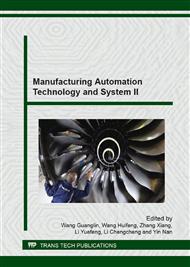p.107
p.111
p.121
p.127
p.134
p.140
p.146
p.153
p.158
Research on Ceramics Crack Propagation under the Ultrasonic Vibration Grinding Based on the Nonlocal Theory
Abstract:
This paper researched the crack propagation and the variation of microstructure for ZTA ceramics under ultrasonic vibration grinding. To interpret the phenomenon, the nonlocal theory was introduced to establish the constitutive model under the ultrasonic vibration. Grinding experiments on surface quality of nanoZrO2 ceramic are carried out using diamond grinding in different condition, both with and without ultrasonic vibration. Experimental results show the surface quality after two-dimensional ultrasonic assisted grinding is superior to that after common grinding. Meanwhile, the effects of amplitudes and frequencies on ZrO2 ceramics crack propagation were analyzed by SEM. The results show that the crack propagation rate decrease with the amplitudes and frequencies increasing, this is because that the nonlocal attenuation ratio reduced and the nonlocal effects also the strongest. The results of experiments are in accordance with the theoretical conclusions drawn from the nonlocal theory, which verifies that the act ion of ultrasonic vibration can actually postpone the ceramic crack propagation rate.
Info:
Periodical:
Pages:
134-139
Citation:
Online since:
August 2014
Authors:
Price:
Сopyright:
© 2014 Trans Tech Publications Ltd. All Rights Reserved
Share:
Citation:


